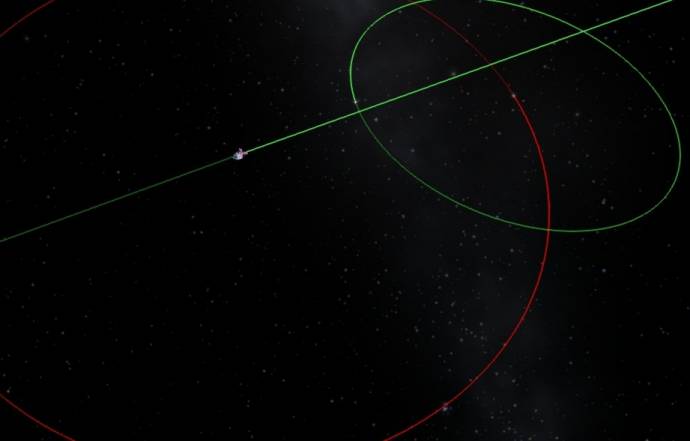|
Science and Astronomy Questions
|
|
| HarbingerDawn | Date: Tuesday, 27.11.2012, 18:39 | Message # 91 |
 Cosmic Curator
Group: Administrators
 United States
United States
Messages: 8717
Status: Offline
| Quote (smjjames) I'm just wondering how close (in distance and orbital period) two stars have to be in order to be considered a contact binary?
It depends on the stars. Very dense stars will be able to get very close to each other before coming into contact, whereas a diffuse star will have its photosphere pulled away towards its partner more easily. There is no set distance/period for determining contact binaries, you would need to figure out the equations and run them for every star you encountered to figure out whether they would be or not.
All forum users, please read this!
My SE mods and addons
Phenom II X6 1090T 3.2 GHz, 16 GB DDR3 RAM, GTX 970 3584 MB VRAM
|
| |
| |
| SpaceEngineer | Date: Tuesday, 27.11.2012, 20:00 | Message # 92 |
 Author of Space Engine
Group: Administrators
 Russian Federation
Russian Federation
Messages: 4800
Status: Offline
| Quote (smjjames) I'm just wondering how close (in distance and orbital period) two stars have to be in order to be considered a contact binary?
If distance between stars is equal to sum of their radii, they are contact  In reality it is more complex, because close stars disturb the shape of each other, and rotate around their common center of mass very quickly, this disturbs their shape even more. In reality it is more complex, because close stars disturb the shape of each other, and rotate around their common center of mass very quickly, this disturbs their shape even more.
And there exists such exotic objects, like two star cores in a mutual envelope.
http://upload.wikimedia.org/wikiped....ova.svg

|
| |
| |
| Salvo | Date: Thursday, 03.01.2013, 14:16 | Message # 93 |
 Star Engineer
Group: Local Moderators
 Italy
Italy
Messages: 1400
Status: Offline
| [Merged from another thread]
Could a moon have its own moon?
Do you think it's possible?
What are the conditions for this to happen?
The universe is not required to be in perfect harmony with human ambition.
CPU: Intel Core i7 4770 GPU: ASUS Radeon R9 270 RAM: 8 GBs
(still don't know why everyone is doing this...)
Edited by Salvo - Thursday, 03.01.2013, 14:19 |
| |
| |
| Tim | Date: Thursday, 03.01.2013, 14:28 | Message # 94 |
 Explorer
Group: Users
 Belgium
Belgium
Messages: 296
Status: Offline
| I believe that in very rare occasions, it's possible, if the moon is far enough from its parent and if it has enough mass. We've been or we are able to put sattelites in orbit around our moon, why would a natural sattellite not be able to do it by coincidence? Or maybe just temporary until the dwarf moon gets caught in the orbit of its grandparent.
Either way, it intrigues me how Pavone wants to place a small "mothership" for his robot hedgehogs in orbit around Phobos within ten to twenty years.
|
| |
| |
| HarbingerDawn | Date: Thursday, 03.01.2013, 14:46 | Message # 95 |
 Cosmic Curator
Group: Administrators
 United States
United States
Messages: 8717
Status: Offline
| Unless the moon formed in that position (would have to be very rare) then it is extremely unlikely. The Hill sphere of the parent moon would be so small that a capture scenario would be practically impossible (unless it was captured from within that same system, eg., Titan capturing Hyperion). So it could theoretically happen, but it would be a very unlikely occurrence (as we can see in our own system, where there are no such bodies).
Also, I think that astronomy questions should be posted in the astronomy questions thread (I'll merge this one).
All forum users, please read this!
My SE mods and addons
Phenom II X6 1090T 3.2 GHz, 16 GB DDR3 RAM, GTX 970 3584 MB VRAM
Edited by HarbingerDawn - Thursday, 03.01.2013, 14:50 |
| |
| |
| Salvo | Date: Thursday, 03.01.2013, 15:22 | Message # 96 |
 Star Engineer
Group: Local Moderators
 Italy
Italy
Messages: 1400
Status: Offline
| In Space Engine is possible

Mars will get angry if he finds out that I stolen him a moon 
(HarbingerDawn) I think that astronomy questions should be posted in the astronomy questions thread
Good idea, but you should change the name
The universe is not required to be in perfect harmony with human ambition.
CPU: Intel Core i7 4770 GPU: ASUS Radeon R9 270 RAM: 8 GBs
(still don't know why everyone is doing this...)
Edited by Salvo - Thursday, 03.01.2013, 15:30 |
| |
| |
| HarbingerDawn | Date: Thursday, 03.01.2013, 15:41 | Message # 97 |
 Cosmic Curator
Group: Administrators
 United States
United States
Messages: 8717
Status: Offline
| (Salvo) Good idea, but you should change the name
I thought about it, but it seems good enough for now. I figured that most people would understand its purpose.
All forum users, please read this!
My SE mods and addons
Phenom II X6 1090T 3.2 GHz, 16 GB DDR3 RAM, GTX 970 3584 MB VRAM
|
| |
| |
| Spyro | Date: Sunday, 03.02.2013, 02:31 | Message # 98 |
 Explorer
Group: Users
 United States
United States
Messages: 162
Status: Offline
|
Lol 
Replying to old posts once agian.
I'm back, but am I here to stay? Hopefully!
|
| |
| |
| Disasterpiece | Date: Sunday, 03.02.2013, 07:45 | Message # 99 |
 World Builder
Group: Users
 United States
United States
Messages: 640
Status: Offline
| How do galaxies get their spiral arms? I read something about density waves but that doesn't make sense in a vacuum.
I play teh spase engien
|
| |
| |
| neutronium76 | Date: Sunday, 03.02.2013, 11:07 | Message # 100 |
 World Builder
Group: Users
 Greece
Greece
Messages: 718
Status: Offline
| From a quick search in google I came into conclusion: We still don't really know. There are some good wiki articles and also this one which is quite old (1998):
http://casa.colorado.edu/~danforth/science/spiral/
Quote (Disasterpiece) I read something about density waves but that doesn't make sense in a vacuum
Space is not a vacuum. It depends on scales: If you take 1x1x1 mile cube in space it is vacuum. If you take 1x1x1 parsec could be vacuum but not very vacuum. If you take 1x1x1 kiloparsek it is definetely not vacuum 
PC1:Core i7 970@3.34GHz, 6 cores/12 threads, 12GB DDR3 RAM@1.34GHz, 2x(SLI) GTX-580 GPUs 3GB VRAM(GDDR5)@1GHz, OS:Win7x64SP1
PC2:Core2Quad X9770@3.2GHz, 2 cores/4 threads 4GB DDR2 RAM@1GHz, GTX-285 GPU 1GB VRAM(DDR3)@1.24GHz, OS:WinVistax64SP2
|
| |
| |
| Salvo | Date: Sunday, 03.02.2013, 11:32 | Message # 101 |
 Star Engineer
Group: Local Moderators
 Italy
Italy
Messages: 1400
Status: Offline
| Quote (Disasterpiece) How do galaxies get their spiral arms?
I've always wondered, but you can see a similar effect on water (microgravity):
Or in cyclones...
The universe is not required to be in perfect harmony with human ambition.
CPU: Intel Core i7 4770 GPU: ASUS Radeon R9 270 RAM: 8 GBs
(still don't know why everyone is doing this...)
|
| |
| |
| HarbingerDawn | Date: Monday, 04.02.2013, 00:33 | Message # 102 |
 Cosmic Curator
Group: Administrators
 United States
United States
Messages: 8717
Status: Offline
| Quote (Salvo) you can see a similar effect on water Or in cyclones...
Spiral forms are ubiquitous throughout the cosmos, but with many different unrelated causes.
All forum users, please read this!
My SE mods and addons
Phenom II X6 1090T 3.2 GHz, 16 GB DDR3 RAM, GTX 970 3584 MB VRAM
|
| |
| |
| Watsisname | Date: Monday, 04.02.2013, 01:28 | Message # 103 |
 Galaxy Architect
Group: Global Moderators
 United States
United States
Messages: 2613
Status: Offline
| Quote (Disasterpiece) How do galaxies get their spiral arms? I read something about density waves but that doesn't make sense in a vacuum.
As neutronium said, you need to consider the scales involved. At kilo-parsec scales calling space a vacuum isn't a good characterization.
Galactic spiral arms arise because some driver (perhaps the gravitational influence of the central bar, or another galaxy nearby) causes the stars in the disk to orbit in an organized way. They still follow fairly circular paths, but the paths "line up" in such a way that there is an increase of density in some places and a decrease in others. See illustration on wiki page. These regions of increased density lead to the spiral arms.
Now stars pretty much pass right through the density wave as if it's not even there, but molecular gas/dust clouds are very much affected and become compressed, causing new star formation to occur. This explains why we see a lot of bright young blue stars associated with the arms, as they don't live long enough to travel far from their birthplace.
This Hubble image shows really well how the spiral arms lead to a concentration of dust clouds, and the abundance of blue stars along with them. 

|
| |
| |
| SpaceEngineer | Date: Monday, 04.02.2013, 16:12 | Message # 104 |
 Author of Space Engine
Group: Administrators
 Russian Federation
Russian Federation
Messages: 4800
Status: Offline
| Quote (Watsisname) They still follow fairly circular paths, but the paths "line up" in such a way that there is an increase of density in some places and a decrease in others. See illustration on wiki page. These regions of increased density lead to the spiral arms.
Note: He means density of stars here.
In science there are a lot of things that have the same names, because they are defined in a similar way. The word "density" may mean not only density of a liquid or a gas (defines as a mass divided by volume), but also [volume] density of stars in the galaxy (defined as a summary mass of stars divided by volume), or [surface] density of a protoplanetary disk (defined as a summary mass of gas divided by a square in the disk's plane). There are a lot of similar words. For example, many people think the term "flat Universe" of "flat space" is incorrect. How can space be flat if it is volumetric right here? So scientists made up weird theories, that make no sense in the real world! In fact, "flat" means Euclidean, i.e. non-curved. So a "flat Universe" means just that space is not curved.
*

|
| |
| |
| HarbingerDawn | Date: Saturday, 09.03.2013, 10:48 | Message # 105 |
 Cosmic Curator
Group: Administrators
 United States
United States
Messages: 8717
Status: Offline
| Here's a question that I used to wonder about years ago, and which is hard to find an answer for (for obvious reasons). I'm hoping that one of the more learned members of this forum might be able to attempt to answer it.
What is the albedo of the Sun?
All forum users, please read this!
My SE mods and addons
Phenom II X6 1090T 3.2 GHz, 16 GB DDR3 RAM, GTX 970 3584 MB VRAM
|
| |
| |